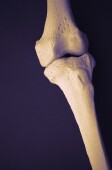Findings in early-postmenopausal osteopenic women, with no leveling-off effect after 16 years
WEDNESDAY, Aug. 19, 2015 (HealthDay News) — For early-postmenopausal osteopenic women, exercise is consistently favorable for bone mineral density (BMD) over a prolonged period, according to a study published online Aug. 1 in the Journal of Bone and Mineral Research.
Wolfgang Kemmler, Ph.D., from the University of Erlangen-Nürnberg in Germany, and colleagues monitored BMD changes over a 16-year period of supervised exercise for 39 exercisers (EG) and 28 non-training controls (CG) who were initially early-postmenopausal osteopenic women with complete BMD datasets for baseline (1998) and four-, eight-, 12-, and 16-year follow-up. The initial exercise protocol focused on a high intensity strategy that addressed bone strength, but then shifted toward a more comprehensive intervention.
The researchers observed a continuous increase in the lumbar spine (LS)-BMD differences between the EG and CG (2.4, 3.1, 3.9, and 4.5 percent at years four, eight, 12, and 16, respectively). Similar differences were seen for femoral neck (FN)-BMD (0.9, 1.9, 2.0, and 3.0 percent, respectively). For both LS and FN, significant differences were found in the final period (P ≤ 0.030).
“We conclude that exercise — even when adapted for subjects decreasing bone, health, and fitness status — is consistently effective in favorably affecting BMD in (initially) early-postmenopausal osteopenic women without any leveling-off effect after 16 years of exercise,” the authors write.
Calcium and vitamin D were provided for the study by Sanofi-Synthelabo GmbH, and elastic bands were supplied by THERABAND.
Abstract
Full Text (subscription or payment may be required)
Copyright © 2015 HealthDay. All rights reserved.








